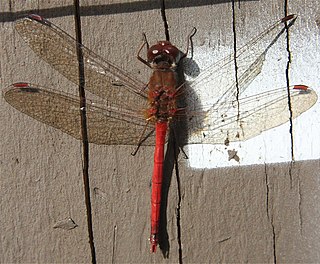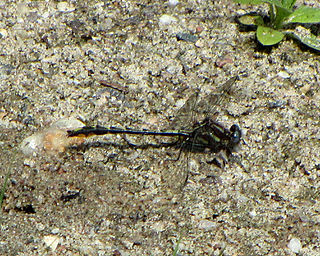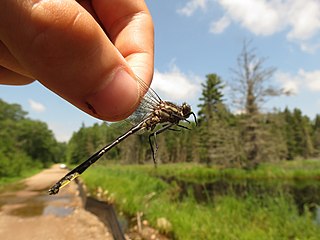
The Gomphidae are a family of dragonflies commonly referred to as clubtails or club-tailed dragonflies. The family contains about 90 genera and 900 species found across North and South America, Europe, Asia, Australia, and Africa. The name refers to the club-like widening of the end of the abdomen. However, this club is usually less pronounced in females and is entirely absent in some species.

The dragonhunter is a clubtail dragonfly of the eastern United States and southeastern Canada.

Gomphus is a genus of clubtail dragonflies in the family Gomphidae.

Sympetrum vicinum, the Yellow-Legged Meadowhawk is one of some fifteen North American species of autumn meadowhawk, which are members of the Odonate family Libellulidae. It grows to 26–35 mm long.

The dot-tailed whiteface is a species of dragonfly in the family Libellulidae. It is also one of the most common and widespread in the genus Leucorrhinia.

The desert whitetail is a species of dragonfly in the family Libellulidae. P. subornata is often put into the genus Libellula.

Sympetrum madidum, the red-veined meadowhawk, is a species of dragonfly in the family Libellulidae.

The boreal bluet is a species of damselfly in the family Coenagrionidae.

Progomphus borealis is a species of dragonfly in the family Gomphidae. This dragonfly species is commonly known as the gray sanddragon.

Gomphurus externus, the plains clubtail, is a species of dragonfly in the family Gomphidae.

Phanogomphus quadricolor, the rapids clubtail, is a species of dragonfly in the family Gomphidae. It is found in eastern North America. Its natural habitat is medium to large rivers. It is threatened by degrading habitat quality.

The Hudsonian whiteface is a species of dragonfly in the family Libellulidae. Its common name comes from where it is found, Hudson Bay.

Phanogomphus exilis, the lancet clubtail, is a species of dragonfly in the family Gomphidae widespread and common throughout southern Manitoba, Ontario, and the northeastern United States.
Burmagomphus pyramidalis, the sinuate clubtail, is a species of dragonfly in the family Gomphidae. It is found in India and Sri Lanka. There are 2 subspecies, where they are geographically separated.

Macrogomphus wynaadicus is a species of dragonfly in the family Gomphidae. It is endemic to the Western Ghats of India.

Paragomphus lineatus, the lined hooktail, is a species of dragonfly in the family Gomphidae. It is a widespread species; recorded from India to Turkey.

Phanogomphus borealis, the beaverpond clubtail, is a species of clubtail dragonfly in the family Gomphidae. It is found in the northeastern United States and southeastern Canada.

Phanogomphus is a genus of clubtails in the family Gomphidae found in North America. There are about 17 described species in Phanogomphus.

Phanogomphus militaris, the sulphur-tipped clubtail, is a species of clubtail dragonfly in the family Gomphidae. It is found in central North America.

Megalogomphus superbus, is a species of dragonfly in the family Gomphidae. It is known only from the Western Ghats of India.



















